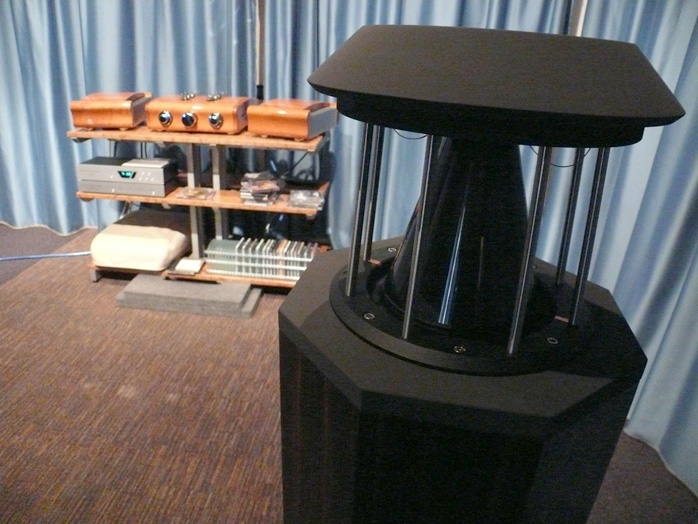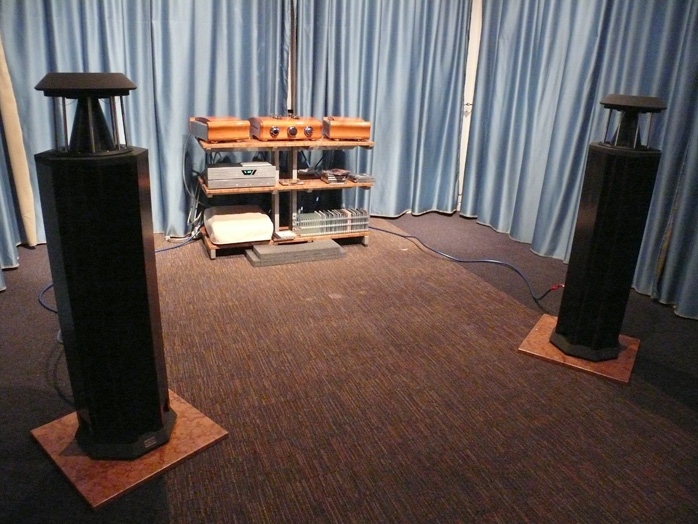 |
I began my informal audition over the Sonus Faber Elipsa speakers whose warm fuzzy voicing did little to show off the potential I assumed the electronics were hiding beneath those swooping gleaming exteriors. The resultant sound was what the average audiophile seems to expect from tubes - nice.
|
 |
It was soft on dynamics and impact and veiled on resolution. As such, it was not emotionally persuasive at all.
|
 |
A far more transparent and exciting choice were these small German Physiks HRS 120 omni speakers. Above 210Hz, they feature the company's Carbon-fiber take on the Ohm Walsh bending-wave driver and a single downfiring woofer below. Absoluta might use this pair in their small ground-floor cubicle at the upcoming Munich show. While the woofer could overload at very stout levels in the larger Padua room, the overall sound rather accelerated in speed, excitement and resolution over the far more genteel Sonus Faber aesthetic. What's Italian for Gemütlichkeit? Confortevolezza. The Germans didn't have the same speed limit.
|
 |
|
 |
Next we visited Armonia Loudspeakers 100 meters down the street in the same business park.
|
 |
Armonia's TWR180 Sinfonia is a 3-way bass-reflex design with a dipole panel consisting of a proprietary folded Kapton film with embossed circuitry clamped between Neodymium stick magnets. This mid/tweeter array runs five vertical slots. In the middle is the isodynamic compression tweeter with single cavity. It is 4mm wide and 0.09 grams in mass, i.e. 1/10th as heavy as a typical dome tweeter. Like the 2+2 cavity midrange panel, the amplifier sees the tweeter as a nearly resistive load. A 1st-order network at 6kHz divides the panel while another 1st-order filter at 200Hz hands over to dual Seas woofers in a rear-ported enclosure.
|
 |
The smaller TWR250 Concerto is a 2.5 way with a TICCS tweeter and dynamic mid/woofer and woofer. Shown here are the upscale silver/gold finishes. Wood veneer with black grills is the standard trim.
|
 |
By folding their midrange diaphragm faintly reminiscent of Heil, the bigger Sinfonia model combines the reflexes and transparency of electrostatics with the impact of dynamic transducers. Therein lies potential agonia rather than armonia.
|
 |
Hybrid electrostats like MartinLogans always suffer from their attempted marriage of dissimilar technologies. Armonia's present approach escalates this common challenge because their panels quite exceed the electrostatic drivers I'm familiar with in dynamics.
|
 |
Armonia's patent-pending TICCS driver is so fast that the spectral decay of the presently mated woofers (and/or their specific loading) is plainly too dissimilar, their dynamic behavior seriously compressed by comparison. As a result, these speakers lack bass - subjectively. Armonia's men below insisted that their speaker measures perfectly linear at 3 meters. I'm sure it does. But because transient reflexes above 400Hz were so much stronger than below, one interprets this type of dynamic nonlinearity as excess loudness for the isodynamically covered bands (or insufficient loudness in the bass). The natural reflex then is to pump up the volume. Alas this only exasperated the issue. Now the panels really led the parade.
|
 |
Above 400Hz, the Armonias utterly obliterated the Sonus Fabers which were moved into the same system for a direct comparison. Yet cello and piano lacked weight, body and impact, drums wanted for crunch and pop and Pavarotti sounded outright emasculated. It was all about speed and exceptional detail.
|
 |
The Elipsas were terribly polite and boring by comparison. They really stepped on the brakes. Still, they were the ultimately far more balanced design.
|
 |
The Armonia team around Nicola Lollo [lower right] has managed to bottle lightning in a sheet of Kapton. At present, it's sadly grafted to a horse carriage. I'm overdrawing for emphasis of course. Something very promising is indeed afoot here but these gentlemen must first rethink their bass system to create unbroken top-to-bottom coherence and migrate their film's liberated reflexes all the way into the bassment.
|
 |
If they can manage—other hybrid panels have failed in the past—I would be sorely tempted to revisit Padova just to hear these again.
|
 |
At this juncture of our short Tuesday through Friday visit, we had mere hours before our scheduled return flight. Fortunately the Icelandian volcano eruption which would shut down 16.000 European flights by the weekend had not impacted Italy and Switzerland so we managed to depart as planned. I already knew that the Absoluta electronics could do very high resolution and accelerated rise times by having eliminated signal-path capacitors. They also could present a grandly layered stage with sharp separation to cover the usual audiophile suspects. Thus far my heart strings hadn't stirred however. With six custom CD compilations of well-loved tracks, they should have been in overdrive. But I still had not heard those highly favorable qualities in the power zone and low bass. While the latter isn't completely essential, impact plus weightiness in the upper bass are absolutely vital to get emotionally engaged. This the Armonia hybrids lacked. Since electronics by themselves make no sound, I still didn't know whether Absoluta had it all. |
  |
 |